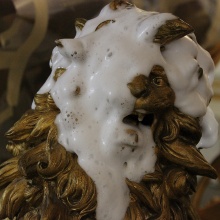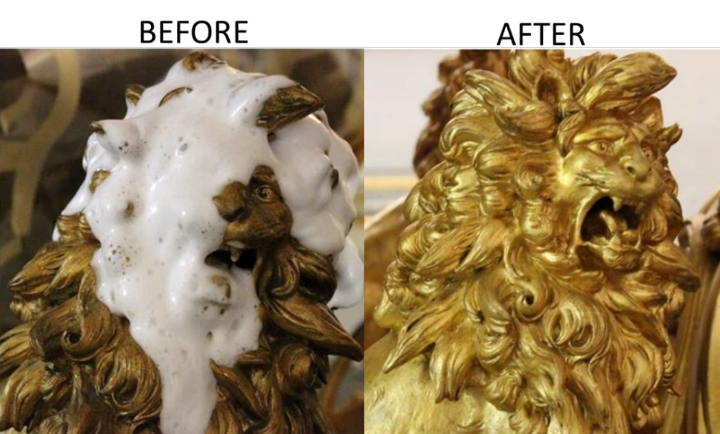Historische Kunst- und Kulturobjekte haben oft stark verschmutzte Oberflächen, da sie über viele Jahre hinweg unterschiedlichsten Umwelteinflüssen ausgesetzt sind. Ein deutsch-französisches Team um Prof. Cosima Stubenrauch von der Universität Stuttgart erforscht nun, wie man die Kostbarkeiten mit flüssigen Schäumen schonend und umweltfreundlich reinigen kann. Erste Ergebnisse wurden im Journal of Colloid and Interface Science publiziert.
There are about 40 coaches of various types and epochs in the Carriage Museum at Nymphenburg Palace in Munich. They all have one thing in common: Their surfaces are soiled from years of dust, soot, and greasy substances. Cleaning them is a huge challenge, as each surface requires specific cleaning methods, so that dirt can be removed without damaging the historical artworks. “This is difficult to do using cotton balls and Q-tips,” explains Heinrich Piening from the Bavarian Administration of State-Owned Palaces, Gardens and Lakes. As the deputy head of the conservation department, he is responsible for the maintenance of the coaches in Nymphenburg Palace - and he noticed that “cleaning agents work better when you foam them up.”
This may not sound unusual to laypeople, but it is: “Normally, foam facilitates the application and incorporation of a cleaning agent. But independent cleaning power has not yet been attributed to it,” explains Prof. Cosima Stubenrauch from the Institute of Physical Chemistry at the University of Stuttgart and adds: “Unless the foam has a specific structure.”
90 percent less cleaning agent
To investigate this phenomenon, the groups led by Cosima Stubenrauch (University of Stuttgart & University of Strasbourg Institute for Advanced Study USIAS, France) and Wiebke Drenckhan (University of Strasbourg - CNRS) have joined forces with Dirk Blunk (University of Cologne) and conservator Heinrich Piening (Bavarian Palace Department). The research team discovered the great potential that liquid foams can have in cleaning works of art: Liquid foams not only reduce the required amount of cleaning agent by up to 90 percent and enable the wetting of complex surface structures, they also activate additional physical cleaning mechanisms.
It has been known for some time that foams - similar to sponges - can “suck” away dirt from surfaces. But now the team has shown that this cleaning mechanism is much more efficient when the foam bubbles perform additional “wiping” activities on the surfaces. “You can think of it like wiping a dirty table top,” Cosima Stubenrauch explains: “Liquid foams are generally unstable, which is shown by the fact that the foam bubbles are constantly bursting and moving around. This instability causes the “wiping” motion.”
This part of the cleaning process can be optimized, if the foams used have the “right” instability: They must be stable enough to exert the “sponge effect”, but at the same time they must be unstable enough to ensure optimum “foam bubble wiping”. Together, these two effects achieve such high effectiveness that it is sufficient to simply let the foam act on the surface for a while before it is removed. Another mechanical activity isn’t necessary.
After the basic principle was demonstrated on sample surfaces, the concept is now to be tested on real historical objects and other types of surfaces.
Expert Contact:
Prof. Dr. Cosima Stubenrauch, University of Stuttgart, Institute of Physical Chemistry, research group Colloid and Interface Science, Phone +49 (0)711/685-64470, E-Mail
Originalpublikation:
Schad, T., Preisig, N., Blunk, D., Piening, H., Drenckhan, W., & Stubenrauch, C. (2021). Less is more: Unstable foams clean better than stable foams. Journal of Colloid and Interface Science, 590, 311–320.



